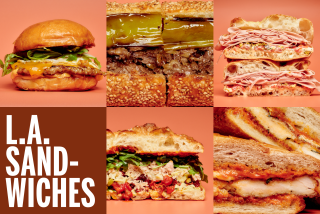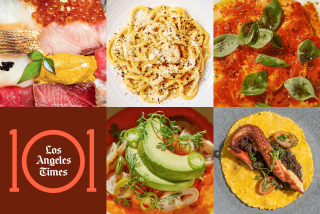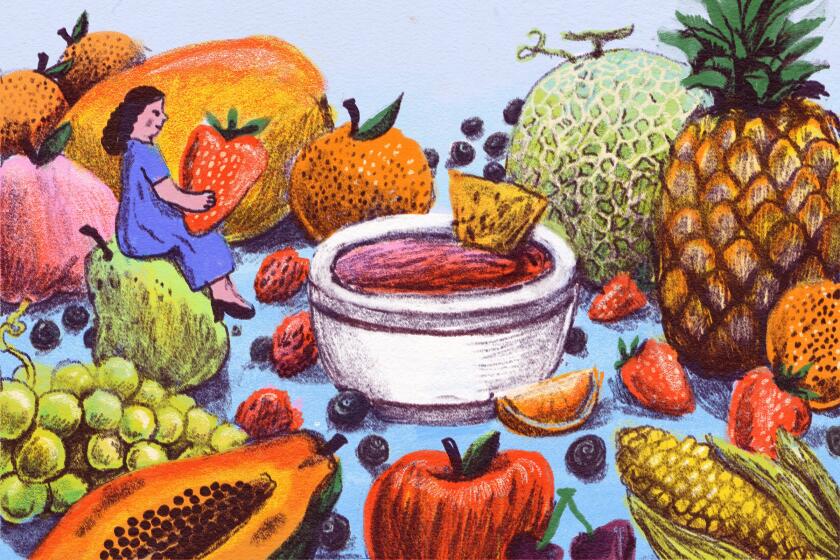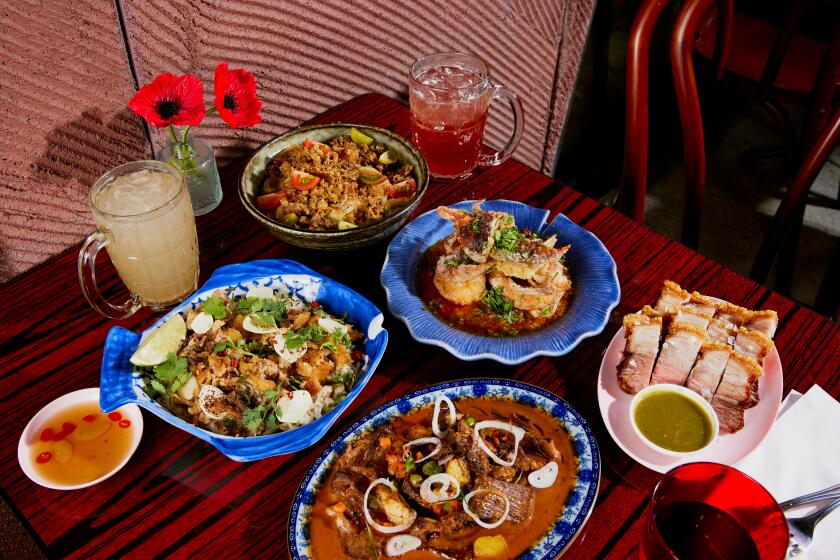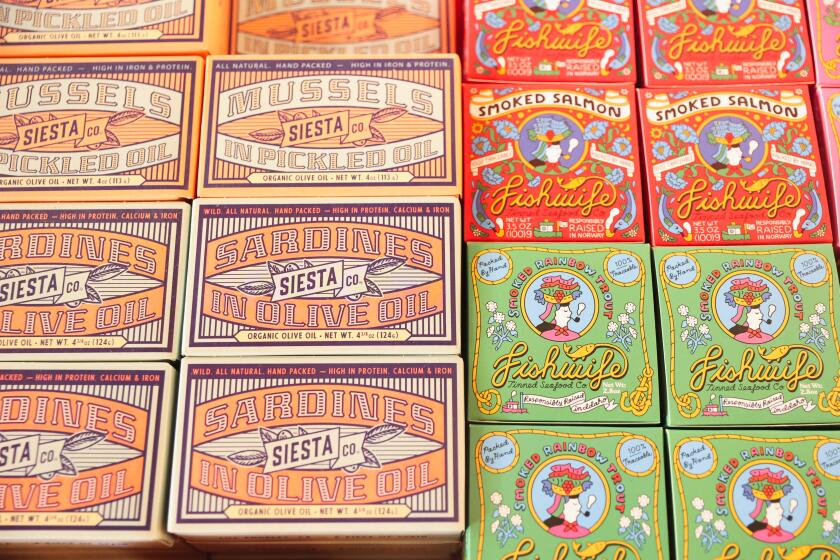A Fish With No Name
Everyone loves sushi, but not everyone understands it. Yes, Los Angeles is home to countless prosaic mini-mall sushi bars, but unless the fish is phenomenally fresh, it’s probably not a bad idea to medicate it with chile and wasabi, the better to disguise the taste. As with so many other things in life, if you want the best, you have to pay for it. If you’re willing, you can pick from a handful of sushi restaurants here that rival Tokyo’s best; among them, Mori Sushi in West Los Angeles.
The restaurant keeps a low profile. It was months before I heard about it, and it’s not that easy to spot on a rainy night. Located at the corner of Pico and Gateway boulevards, in one of those odd juxtapositions you find only in L.A., it sits across the street from Fantasy Island, a gentlemen’s club that advertises showgirls and a Monday night bikini contest. There’s nothing that says “Mori Sushi” on the outside; look for the building on the southwest corner surrounded by clumps of bamboo, with a line drawing of a fish mounted high on a pole.
When you poke your head in the door, you’ll get a rousing welcome from Morihiro Onodera and his two assistants. At one end is the sushi bar, which seats about eight. There are also 12 or so tables that, like the counter, are made of laminated plywood finished to a high gloss. The modest space is painted a creamy white. Beneath the high ceiling, a flock of white Japanese paper lanterns bobs in the slight breeze. The sole spots of color--and they are subtle--are three paintings behind the sushi counter.
One visit was all it took to put Mori Sushi high on my list for the quality of the fish and the skill of its sushi chefs. Red snapper is striated with pearly rose. Onodera’s well-marbled toro has a velvety texture. Octopus carpaccio gets a light dusting of crushed pink peppercorns and a dribble of green-gold olive oil. Salt squid is cut to resemble a chrysanthemum.
I like watching Onodera’s quick, sure movements as he scoops up the rice and works it into a perfectly elongated oval. Unlike sushi rice at most places, his isn’t sweet. And he never makes oversized sushi; everything is bite-sized, the way it should be. At most, you may choose to dip some sushi pieces (fish side down) in a light bath of soy sauce, but the sushi chef has already seasoned most things, slipping a little freshly grated wasabi root beneath the fish, or adding a gentle squeeze of yuzu or a sprinkling of Japanese sea salt.
After ordering for myself the first time, on subsequent visits I just let Onodera take charge, asking for omakase, or chef’s choice. He started off a little cautiously, nothing too challenging, but each time I returned he offered me something more unusual, something more surprising.
It might be a little plate of “ginger sardine,” dark, flavorful chunks of sardine topped with matchsticks of ginger that cut the oiliness of the fish. He might offer a piece of fine-grained silver fish. “A type of shad,” he says. Or a single live Santa Barbara spot prawn, split and broiled with skeins of bright red roe inside. Taste this and you’ll understand what fresh means. It’s a feast in a shell.
One night, a friend and I are seated at the counter next to a rapt fan, who questions the sushi chef closely about everything. The diner tells me he used to eat sushi 10 times a week, but has recently cut back a bit. Nonetheless, he still seems to know every sushi chef of consequence in L.A. He was going to Ginza Sushiko when it was still in a mini mall, long before it moved to posher quarters in Beverly Hills. He’s followed Onodera’s career from Katsu and Matsuhisa to a little place in Brentwood and now to this 11-month-old restaurant. He whispers that Onodera designed the restaurant himself and did most of the work.
I can’t stop thinking about eating sushi 10 times a week. Isn’t that rather excessive? I think of great sushi more as special occasion eating. That kind of dedication must have something to do with the display of connoisseurship or the relationship that develops between a sushi chef and his client. You slip into a seat at the bar. You inspect the seafood. You ask the master to feed you, bite by bite like a mother bird feeding her chick. It can be very soothing, much more than visiting your analyst and about the same price.
But Onodera doesn’t even need to have you sitting in front of him to know what you’d like to eat. He intuits it. He may start with a long, skinny platter (he makes almost all the pottery himself) arranged with little tastes: incredibly crunchy--and loud--herring roe with a vein of seaweed running through the middle, a pickled kumquat, a sweet shrimp. He might follow that with a salad of small, perfect arugula leaves covered with crab meat and the rich, odiferous crab “butter” in the inside of the shell.
I’ve eaten things here I’ve never even seen before. A lidded lacquer bowl holds a wonderful light broth with what looks like a snowball in the middle. Our waiter tries to explain. It’s something in tempura batter. But what? She takes out a pad of paper and draws a lily--and its bulb. The snowball is a lily bulb pounded together with a little potato. The bulb flakes into petals and tastes starchy and faintly sweet. A leaf-shaped plate holds Japanese scallops, sliced in half moons, marked by the grill and topped with gorgeous ochre uni roe. Another time Onodera serves lightly broiled uni atop sushi rice in an abalone shell.
Dessert? Choose the fruit, a generous bunch of dark purple grapes served in an iced bowl. The size of quail eggs, the grapes taste dark and sweet and have a little kick of tannin. The only garnish is a sprig of mint leaves. That minimalism and that aesthetic, letting a great product alone, is what makes a serious sushi restaurant. And Mori, despite its modest setting, is one.
Mori Sushi
11500 W. Pico Blvd.
West Los Angeles
(310) 479-3939
Cuisine: Japanese
Rating: **1/2
AMBIENCE: Simple, somewhat austere space with counter and tables. SERVICE: Friendly and willing, though English sometimes shaky. BEST DISHES: Sushi, sashimi, broiled spot prawn, octopus carpaccio, arugula and crab salad, omakase selections. Dishes, $2.50 to $15; omakase, $50 to $90 per person. Corkage, $10. DRINK PICK: Kirin beer. FACTS: Dinner Monday through Saturday. Lunch weekdays.
*
Rating is based on food, service and ambience, with price taken into account in relation to quality. ****: Outstanding on every level. ***: Excellent. **: Very good. *: Good. No star: Poor to satisfactory.
More to Read
Eat your way across L.A.
Get our weekly Tasting Notes newsletter for reviews, news and more.
You may occasionally receive promotional content from the Los Angeles Times.
